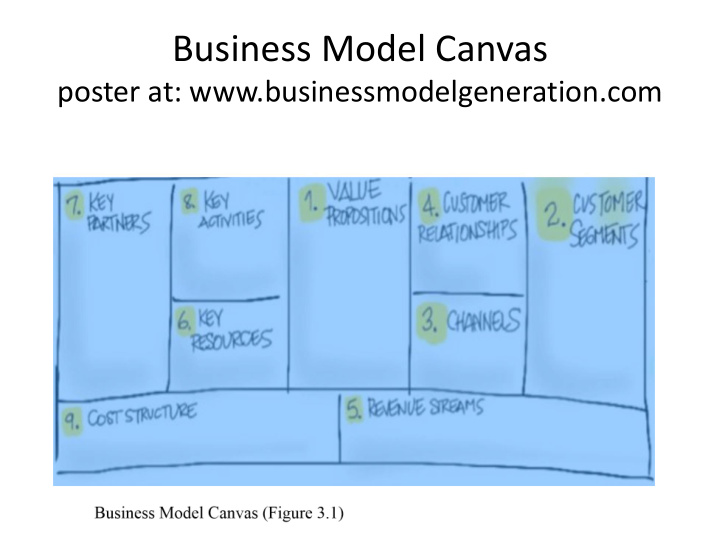



Business Model Canvas poster at: www.businessmodelgeneration.com
Customer Development Manifesto • Rule No. 1: There Are No Facts Inside Your Building, So Get Outside. • — Rule No. 2: Pair Customer Development with Agile Development • — Rule No. 3: Failure is an Integral Part of the Search • Rule No. 4: Make Continuous Iterations and Pivots — • — Rule No. 5: No Business Plan Survives First Contact with Customers So Use a Business Model Canvas • — Rule No. 6: Design Experiments and Test to Validate Your Hypotheses • — Rule No. 7: Agree on Market Type. It Changes Everything • — Rule No. 8: Startup Metrics Differ from Those in Existing Companies • — Rule No. 9: Fast Decision-Making, Cycle Time, Speed and Tempo • — Rule No. 10: It’s All About Passion • Rule No. 11: Startup Job Titles Are Very Different from a — Large Company’s • — Rule No. 12: Preserve All Cash Until Needed. Then Spend • — Rule No. 13: Communicate and Share Learning • — Rule No. 14: Customer Development Success Begins With Buy-In
Lessons from Webvan • ASSUMING "I KNOW WHAT THE CUSTOMER WANTS" • ASSUMING "I KNOW WHAT FEATURES TO BUILD" • FOCUS ON LAUNCH DATE • EMPHASIS ON EXECUTION INSTEAD OF HYPOTHESES, TESTING, LEARNING AND ITERATION - TRADITIONAL BUSINESS PLANS PRESUME NO TRIAL AND NO ERRORS • EMPHASIS ON JOB TITLES VERSUS GETTING THE JOB DONE • SALES AND MARKETING EXECUTE TO A PLAN • PRESUMPTION OF SUCCESS LEADS TO PREMATURE SCALING • MANAGEMENT BY CRISIS LEADS TO DEATH SPIRAL • Relan insight: EGO of CEO – REFUSAL TO ACKNOWLEDGE ERROR AND PIVOT, ULTIMATELY LED TO BANKRUPTCY
Key Difference: Search vs Execution
Developing Insight
Customer Discovery Process
Validation Process
Four Phases of Customer Validation Process • Phase 1 consists of six “get ready to sell” activities; product positioning, sales/ marketing materials for “test selling” efforts, the hiring of a sales closer, the creation of a distribution channel plan, refining a sales roadmap, and creating an advisory board. These activities make your team the best prepared early stage venture ever to hit the streets. • Phase 2 gets founders out of the building to put the product to the ultimate test: will customers validate your business model by buying your product? Dozens if not hundreds of meetings help refine the product presentation and channel plans, validate the sales roadmap, prove the predictability of the sales funnel, and validate that the business model is repeatable, scalable and profitable in a real-world test. • Phase 3 happens once you have a couple of orders under your belt and enough customer information to develop and refine your product and company positioning. The positioning is tested in meetings with industry pundits and analysts and face-to-face with the expanded customer audience. • Phase 4 stops all activity for long enough to conduct a detailed pivot-or-proceed analysis and verify that, regardless of channel, customer validation is complete and the company knows how to scale.
Recommend
More recommend